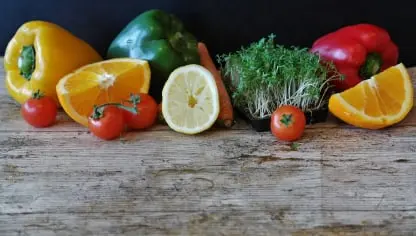Pepper management quality app with AI powered QC:
Pepper & capsicum management quality app management with AI manages your entire pepper & capsicum quality during packing, storage, sales & shipping. Slash Food Safety costs. Eliminate waste, price negotiations, and QC mistakes. Maximize quality consistency.

Pepper Food Safetys during production
View app Specifications.
Twelve random samples of pepper powders were analyzed for contamination by microorganisms of public health significance (bacteria, moulds) and for aflatoxin B1 concentration. Black peppers were more heavily contaminated than white peppers but the most important bacteria causing foodborne diseases were not isolated; The mould flora was dominated by xerophilic species, particularly Aspergillus fumigatus, A. flavus, A. niger and A. ochraceus. These potentially pathogenic species can be dangerous for predisposed patients. The most striking result concerns aflatoxin B1 which was detected in every sample analyzed and could not always be correlated with the occurrence of a mycotoxinogenic strain of Aspergillus, suggesting the use of a sterilizing treatment previously. So, the detection of aflatoxin B1 must be a necessary criterion to be added to microbial criteria to appreciate the quality of peppers.

Daily Pepper packhouse hygiene checklist
The washing stage from a bell pepper commercial packinghouse was assessed to study some of the critical control points related to bacterial cross-contamination. The washing line comprised two overhead spray bars applications: a pre-wash step without peroxyacetic acid (PAA), and a wash step with PAA. The physicochemical characteristics of the wash water and the bacterial quality and safety of the wash water and bell peppers (including aerobic mesophilic bacteria (AMB), Salmonella spp., and Shiga-toxigenic E. coli (STEC)) were studied. Additionally, the performance of commercial test methods (reflectometry, amperometric probe, chronoamperometric sensor) for measuring the residual concentration of PAA was examined. The bacterial load of the pre-wash water (8.7 ± 1.3 log cfu/100 mL AMB) was very high and thus peppers after the pre-wash showed a significantly higher bacterial load (4.9 ± 0.9 log cfu/g AMB) than the unwashed (3.8 ± 0.7 log cfu/g AMB) or the washed peppers (3.3 ± 0.8 log cfu/g AMB) (p < 0.05). However, no pathogenic bacteria were detected in bell pepper samples (n = 40), and only one water sample was confirmed positive for STEC (n = 64, 1.6% prevalence). The chronoamperometric sensor (PAASense) and the online amperometric probe showed similar results, while the reflectometry (Quantofix) significantly sub estimated (p < 0.05) PAA concentration. The results obtained highlight the need for interventions to improve hygiene in the washing line to ensure the microbiological quality and safety of bell peppers. The maintenance of optimal PAA concentrations in all the washing steps is critical for reducing the chance of water-mediated cross-contamination.

Pepper Food safety
Peppers are a relevant product from the food safety point of view. The presence of pathogenic microorganisms has been detected in peppers (Mukherjee et al., 2004; Cerna-Cortes et al., 2012; Avila-Vega et al., 2014). Furthermore, outbreaks of foodborne illness have been linked to the consumption of pepper (Behravesh et al., 2012; Hassan et al., 2017).
Treatments that effectively inactivate microorganisms in produce wash water are necessary to avoid cross contamination by spoilage microorganisms or pathogenic species (Gil et al., 2009; Gombas et al., 2017; Maffei et al., 2017). With this aim, it is crucial to measure and manage the concentration of active sanitizers in the wash water (López-Gálvez et al., 2019). Food contact surfaces (e.g., roller brushes) can also contribute to microbial cross-contamination events in produce packinghouses (Pao et al., 2009; Nyarko et al., 2018).
Most studies on the microbiological quality of fresh produce wash water have focused on the antimicrobial efficacy of chlorine or chlorine-based compounds, which remain the most widely used sanitizers in the industry (Gil et al., 2016; Azimi et al., 2017; Chen and Hung, 2017; Teng et al., 2018).

Pepper Supplier Food Safety
However, chlorine has some disadvantages, like the formation and accumulation of disinfection by-products, the instability in the presence of organic matter, and the need for pH control (Suslow, 2001; Gil et al., 2009). Peroxyacetic acid (PAA) is an alternative to chlorine-based sanitizers, and its primary user on a global scale is the food industry (Luukkonen and Pehkonen, 2017). Compared with chlorine, PAA presents some positive aspects such as efficacy over a wide pH range, higher stability in the presence of organic matter, and fewer disinfection by-products than chlorine (Kitis, 2004; Lee and Huang, 2019). Disadvantages of PAA could include the higher cost and slower microbial inactivation kinetics compared to chlorine-based sanitizers (Van Haute et al., 2017). Some studies have suggested that PAA is more suitable than chlorine for the washing of peppers taking into account both the reduction of the microbial load (Adler et al., 2016) and effects on postharvest quality (Alvaro et al., 2009). Yuk et al. (2006) reported a lower efficacy of PAA compared with sodium hypochlorite and acidified sodium chlorite for the inactivation of Salmonella spp. in bell peppers. In contrast, Chang and Schneider (2012) and Balaguero et al. (2015) observed high efficacy of PAA in an overhead spray and brush roller system against Salmonella spp. and Pectobacterium in tomatoes. Bang et al. (2017) also reported the efficacy of PAA (200 mg/L) in reducing biofilm formation by Cronobacter sakazakii in cucumbers.